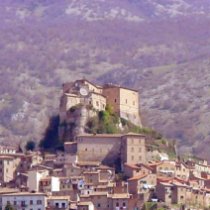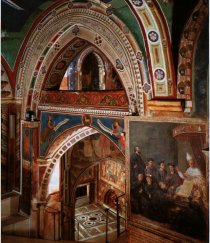From the Middle Age to 20th century
Shortly before 1200 there existed a community of twelve, which Innocent III made a priory; John XXII in 1312 appointed a special abbot. A new road was built by the city in 1688. The sacred grotto is still a favourite pilgrimage, and on October 27 1909, Pius X granted a daily plenary indulgence to those who receive Holy Communion there and pray according to the intention of the Holy Father (Acta. Ap. Sedis, II, 405).
In 1465 the German printers, Sweinheim and Pannartz, established in Subiaco a printing press and printed Donatus pro parvulis, Lactantius, (1465), and De Civitate Dei (1467). Those were the very first books to be printed in Italy.
In 1688 the access to S. Scolastica and to Sacro Speco was facilitated by the opening of a road flanked by a series of chapels. The road passes very near the ruins of a building belonging to Nero's villa: what's left is hardly impressive because all the marbles and columns of the villa were taken away to decorate the monasteries and their churches.
In 1753 Pope Benedictus XIV abolished the feudal rights of the Abbey over Subiaco: the town fell under the direct jurisdiction of the papal state.
A new road linking the town with Tivoli was built in 1773 by order of Pope Pius VI. Pope Pius VI, who lived in Subiaco when he was a cardinal, promoted the development of Subiaco, hedid a lot to improve the economy of Subiaco and to embellish the town. An arch in his honour was erected in 1789 to celebrate the completion of the new road.
In 1798-1799 and 1810-1814 French troops entered the city, ploundering the monasteries and the churches. In 1849 and 1867 Giuseppe Garibaldi conquered the city in his plan to destroy the temporal rule of the Pope: in 1870 the city become definitively part of the Regno d'Italia.
In the first years of the 20th century the area was improved with the connection to a railway, an hydroelectric plant and on aqueduct. Electricity was brought to the houses and a hospital was built. In World War II Subiaco was bombed by Allied planes, who destroyed three buildings out of three, including some historical ones.
Surroundings
-
The Sacro Speco

An impressive complex of buildings which almost looks as if it is one with the surrounding rock...
To know more
-
Rocca Pia
Built on the place where Callisto II Borgia's Castle was situated...
-
Church of St.Peter
It was built on the rests of a roman villa...
Tivoli's attractions

Patrocinio Comune di Tivoli
Assessorato al Turismo




